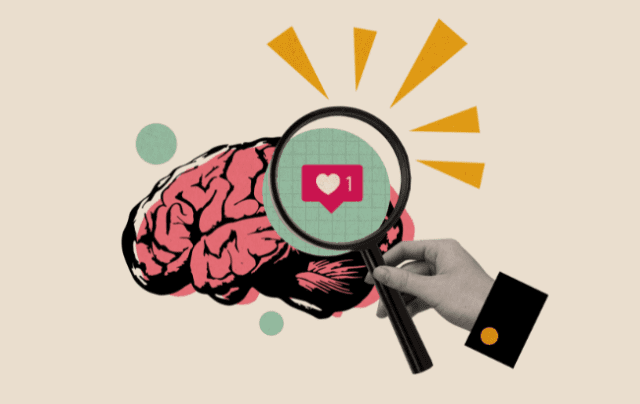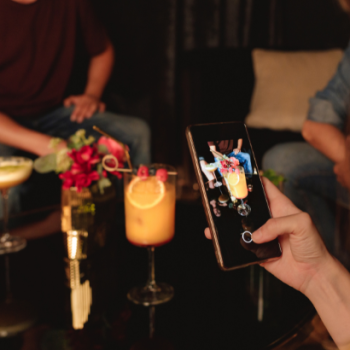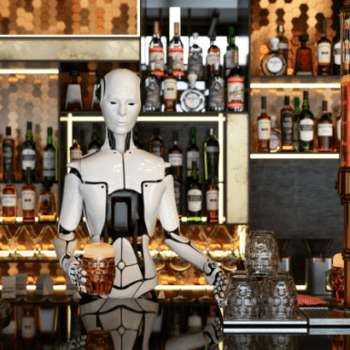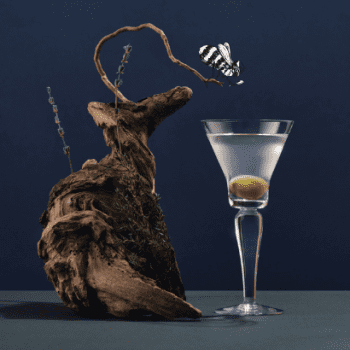Is social media dampening hospitality’s creativity?
By Georgie CollinsIn a world dominated by image-heavy platforms, we’ve become trapped in a cycle of repetitive ideas and copycat campaigns. At this year’s Tales of the Cocktail conference in New Orleans, three drinks industry experts shared why social media and AI are hindering originality within the hospitality sector, and how taking creativity offline can foster genuine ideas.

During a seminar titled Breaking the Algorithm: Developing and Delivering Effective Creativity and Innovation, drinks photographer Addie Chinn, Mr Lyan Studio managing partner Bob Conwell, and Diageo’s head of advocacy Claire Warner discussed how social media has grown to promote superficial engagement, while AI is rapidly replacing human creativity.
“Let’s start with a quick definition of creativity,” began Chinn. “We all think we know what it means to be creative – to come up with a new idea, right? But ideas don’t come out of the ether – they don’t come fully formed, and they don’t exist in an abstract. Ideas are a way of uniquely combining or connecting two or more different things and then using that to efficiently and effectively solve the problem.”
That problem, he explained, might be making a drink that somebody connects with or enjoys, or it might also be a better way of arranging a speed rail creatively. “It’s your unique way of solving that problem,” he said, further explaining that creativity is a full spectrum, ranging from ‘mini-C’ creativity (small, daily creative decisions) to ‘big-C’ professional creativity (using specialised skills) and cultural creativity (shifting cultures).
The social media trap
The average social media user scrolls through approximately 300 feet of content daily, which is equivalent to the height of the Statue of Liberty. This corresponds to approximately three hours spent on social media every day, which over the course of a lifetime, accounts for nine years.
This is not conducive to creative engagement, Chinn explained.
“The algorithm on social media is not there to inspire you. It’s there to trap you. It’s there to keep you scrolling. If you’re doing that all day, you’re not connecting with the content.”
That’s what the algorithm wants, he said. “It’s not serving you content to give you more creativity, so you can go and make new, cool stuff outside of social media. It’s inspiring you to stay on social media, to produce more content for social media, to be on social media for longer, to see how many people have looked at your social media posts, to then swipe through more social media posts.

“While social media isn’t king, it’s not a villain, either,” he added. “Social media is dumb. Social media is a tool. It’s an incredible, revolutionary tool, but it’s a dumb tool.
“Tools are only useful for you to use them. Social media is not a catch-all. There was a beautiful promise at the beginning of Instagram: it was going to democratise creativity. We all suddenly had this platform to be creative on. We were going to share it and be more creative with beautiful photos and stories and project ourselves.
“Sure, it’s raised the creative bar at the bottom – we take better photos – but it’s also trimmed at the top. There’s no room for art on social media, there’s no room for outliers. If you’re making something weird and sculptural, there’s no space for that on social media. So all it has done is close that square.”
The origin of the seminar came from three emails from three different agencies that Chinn received in a single week, all of which were looking to commission ‘a suite of energetic images’. In the briefs he received, all of these inspirational images were taken from Instagram. “If you search ‘dream photography’ on social media, you get what the algorithm thinks you want,” he said. “You’re asking a creative in the least creative way possible to produce more of that.”
He clarified: “I love this industry, and I love photographing drinks, but stop using Instagram for research. Pinterest isn’t any better. Use magazines, books, go to bars, speak to bartenders. But sending photographers images of other people’s drink shots, or even my own drink shots, is not going to further your brand. It’s this race to mediocrity. Social media has told us it is a good thing to be like everyone else.
“Social media is not the best endpoint for everything. It will never replace a gallery, so using it as the only endpoint, or even the target endpoint, is not the way to go about it anymore. It may well have been, but I think we’re all past that. We all know that a ‘like’ or a fire emoji doesn’t mean I liked it. It means I want to be seen to see your posts. It is an empty action.”
‘Fraught with limitations’
In addition to social media, the trio touched upon the creative limitations of using AI to further a hospitality brand or output.
Hospitality, they said, is fundamentally about human experiences, which AI is unable to replicate. It cannot taste, understand body language, or create meaningful connections. It also cannot understand or generate genuine emotions – things that make hospitality so crucial to society.
“AI is fraught with limitations,” Chinn explained, adding that it also comes with ethical concerns. “Every AI search uses 22 times more CO2 than a Google search. That’s not including the water cooling and the E-waste of replacing the hardware to keep up with the software. There’s an ethics to using AI that is very, very dodgy.”
However, he conceded there is a time and a place for using AI in hospitality scenarios, especially as part of a human process.
Conwell explained that at Mr Lyan Studio, AI is used as an efficiency tool, rather than as a creative one.
“As a technology, it has a lot of promise to make us more efficient, more effective in what we do. We use it for research, for note-taking, analysing documents. More recently, we started using generative AI to visualise ideas.” Being able to generate an image on the fly to display what the team has in mind for a client is “super helpful”, he added.

However, he said, while Mr Lyan Studio uses AI in a number of cases, they “never use it to replace the creative process, or that creative leap that you need to make”.
He explained: “AI is just not built for that. It’s derivative. It takes what’s out there and regurgitates it. It’s not illogical in the way that the creative brain needs to be. It doesn’t look in weird places. It doesn’t do weird, imperfect stuff, which is where great creativity comes from. If you are using it for making drink recipes, or writing copy or anything like that, you are in real danger of ending up with mediocre outputs. I think probably most people would agree with that position.”
He added: “I think there’s a hidden risk that is deeper. Using it for things like research, it’s very tempting to get that instant response, that instant bit of information that can help you in your process. But you’re skipping a big part of the creative process. That is where you get the inspiration for your best ideas – the hard graft of research: speaking to people, looking in weird and strange places. That’s where all the good stuff comes.
“You can dull your creative senses by skipping those steps. And when it comes to selling ideas to clients, or getting your team on board, or getting customers on board, a big part of it is your passion. How passionate are you about an idea? And how passionate can you be about something which has been spat out by a computer?”
Chinn added: “There’s an idea for many people that creativity should be easy, and I think AI is only fuelling that. But difficulty and conflict and friction and making mistakes, that’s part of the creative process. Pushing through is the only way you refine it.”
‘The robots are coming’
Where Warner said she sees AI, specifically ChatGPT, being used most frequently is by bartenders who are looking to enter and win World Class.
“It’s obvious when a bartender enters World Class and has used ChatGPT to construct their script,” she said, noting that the tell-tale signs include disingenuous stories about being inspired by a grandmother.
“We tend to see drinks that look and taste like something [that already exists],” she added, using the serves crafted by Mr Lyan Studio founder and acclaimed bar owner Ryan Chetiyawardana as an example. “You know they’re not coming from a genuine place of inspiration. They’re not using ingredients that are local to that particular bartender. We get to this homogenised version of a ‘World Class’ cocktail, which is not drawing from local inspiration or a genuine place of curiosity for the bartender. It’s like typing out ‘how to win World Class’. You’ll get step one to step 10, and your drink will ultimately look like something on Ryan’s menu.
“We are [as an industry] protected to a certain extent, because we talk taste, but as a bartender, don’t be tempted to use it, because it’s always super obvious. You can tell.”
To that point, Conwell added: “We should all remember what industry we’re in – we’re in hospitality. It’s about getting people together, giving them experiences, creating emotions. No computer right now – hopefully for a long time – is able to taste things. They can’t give emotion, can’t understand body language. I guess that’s both a warning, but also a note of positivity in that we’re perhaps insulated. If you’re a banker or a computer programmer right now, you will be shitting yourself that the robots are coming. But in our industry, maybe we’re all right.”
Cross-pollination
The seminar culminated in the message that one of the best ways to inspire or harvest creativity is to go in search of it offline, outside of your primary field.
“One of the things I always task my clients with is: don’t send me pictures of drinks,” Chinn shared. “Send me non-drink pictures that you think speak to your brand. Send me architecture or fashion or lifestyle shoots. Flick through Vogue and cut some stuff out. Don’t go through Imbibe and send me drink inspo. Don’t go on Instagram. Send me the other stuff that speaks to your culture or your mindset – that will allow me to get into your world and be inspired by your world, and how it is related to drinks.”
For Chinn’s ‘Alcohol Free’ series (pictured above), a lot of his ideas came from pushing back on what he does on a day-to-day basis. “The theory was: I wonder if I can photograph a cocktail without photographing a cocktail? Have we trained consumers enough so that they know what a Negroni, a Mojito and a Spritz look like – so I can use colour backdrops and still photography, and they can tell me what it is? This was a Negroni, and the sources were luxury magazines, a bit of Wallpaper. There’s probably a bit of fetish and jewellery stuff with the string and the stretching of the orange on the red background. Very simple, but it took a very long time to make. That idea would never have happened if I just took pictures of Negronis. I had to look outside of that. This whole project would never have occurred if I hadn’t allowed other verticals to inspire me.”

He also shared some imagery from a series he took for the Book of Berries menu at The American Bar at Gleneagles.
“Their menu,” he explained, “was using discarded products from within the hotel and was inspired by the Scottish landscape around them. That was the brief.”
Chinn worked with cosmetic stylist Sophie Iona on the project. This cross-pollination of experience and expertise allowed for a unique form of teamwork, which enabled them to bring together new ideas. Together, they took visual inspiration from ikebana – Japanese flower arranging – and examined the rules of the craft to build unique sets. “The idea was that it needed to be simple enough to linger on Instagram, but we wanted to make images that could allow the aesthetic to soak in and force a bit of calm and focus,” he said.
“The thing I love about it is, through all that cross-pollination, it’s not a drink on a bar top with an out-of-focus bartender pouring into it. It’s not that same stuff. That would never have happened if we hadn’t allowed our social antennae collectively to be inspired by other completely unrelated things. You all need to open that book and let that weird in.”
Related news
Face It Together: Drinks Trust takes social media by storm
